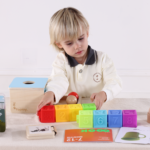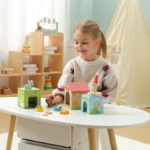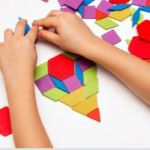In a world increasingly dominated by screens and structured activities, the simple and timeless act of a child engaging in pretend play can feel almost revolutionary. When children immerse themselves in a virtual world, they are engaging in a powerful and complex form of learning. It shapes their cognitive, social, and emotional development in profound ways.
What are the benefits of pretend play?
The Cognitive Workout: Building Executive Function
At its core, pretend play is a fantastic cognitive workout. It requires a child to hold multiple ideas in their mind at once and manipulate them. This is the foundation of executive function—a set of skills that includes working memory, mental flexibility, and self-control.
When a child decides to play “Grocery Store”, they must know the role of cashier and customers. They need to know well the goods in their store, the prices of the goods and how to give change. They learn to think symbolically—a block isn’t just a block; it’s a bread, a cake or a cup of milk. This ability to see one object as another is a precursor to abstract thought, which is crucial for reading, math, and scientific reasoning.

The Social and Emotional Laboratory: Understanding Self and Others
Perhaps the most significant benefits of role-play occur in the social and emotional realm. Pretend play is a child’s personal laboratory for experimenting with emotions and social dynamics.
Emotional Development: Through role-play, children safely explore feelings like fear, excitement, frustration, and joy. They can rehearse scary situations, like a visit to the doctor, transforming anxiety into a sense of control and understanding. They also learn empathy by literally stepping into someone’s shoes. By pretending to be a parent, a teacher, or a firefighter, they begin to see the world from a different perspective, fostering compassion and social awareness.

Social Skills: Cooperative pretend play is a masterclass in social interaction. It needs negotiation (“You will be the owner, and I’ll be the customer”), turn-taking, and communication. Children learn to express their ideas, listen to others, and collaborate to build a shared story. They deal with conflicts, learn the art of compromise, and build the foundational skills for forming healthy relationships.

Language and Communication: Expanding Vocabulary
The language explosion that happens during pretend play is remarkable. As children assign roles and create scenarios, they naturally use a richer and more varied vocabulary. They imitate the sophisticated language they hear from adults—words like “diagnosis,” “engine failure,” or “reservation” suddenly enter their play. This context-driven language learning is incredibly effective. They aren’t memorizing words; they are using them with purpose and meaning, which dramatically enhances their communication skills.

Creativity and Problem-Solving: The Innovation Engine
There are no limits in the world of make-believe. When playing burger shop, children learn to generate multiple ideas and solutions to meet different customers’ need. Some customer does not like onion. Some customers like small burger. They will custom the hamburger based on customer’s need or recommend the one customer may like.

How Parents Encourage Pretend Play?
You don’t need a house full of expensive toys to foster this crucial play. In fact, simpler is often better.
1.Provide Open-Ended Toys: Choose toys that can become anything. Dolls, animal figures, dress-up clothes, and play kitchens are perfect catalysts for imagination.
2.Embrace Simple Materials: Never underestimate the power of simple blocks. It could create many different ideals.
3.Create Space and Time: Ensure children have unscheduled and unstructured time to allow their imaginations to flourish.
4.Be a Supportive Audience: You don’t always need to direct the play. Often, simply being an enthusiastic observer or playing a supporting role (e.g., taking your “order” at their restaurant) is all the encouragement they need.
Classic Pretend Play Toys from Tookytoy
Kitchen Set: Kitchen set toys are designed to simulate real cooking experiences for children. They are typically made from durable and eco-friendly materials like solid wood, MDF, plywood, often coated with non-toxic, water-based paints for safety. These toys commonly include features such as ovens, sinks and storage spaces, along with accessories like pots, pans, utensils and pretending food items.

Doll House: A doll house is far more than a simple toy. It is a miniature toy home designed for creative play. It typically has multiple rooms, tiny furniture and often includes small dolls representing a family. Children learn the room layout (bedroom, living room, dinning room, kitchen, washroom), things and activities in different rooms.

Dressing Table: A dressing table, also called a vanity table, is a piece of furniture designed for grooming, applying makeup and styling hair. It is the perfect place for little ones to dream, play and imagine. Designed just for them, it is a charming and safe spot where they can enjoy pretending to be all grown up. It is more than just a toy, it is a source of confidence, creativity and hours of imaginative fun.

Work Bench: A children’s workbench is a fantastic toy for kids who love tinker, build and create. It is like a mini version of a real workshop, designed just for them. They can pretend to be a carpenter, mechanic or engineer by playing with wooden nails, screws, nuts and bolts. It helps practice hand-eye coordination and fine motor skills. It teaches kids how things fit together and encourages problem-solving.











